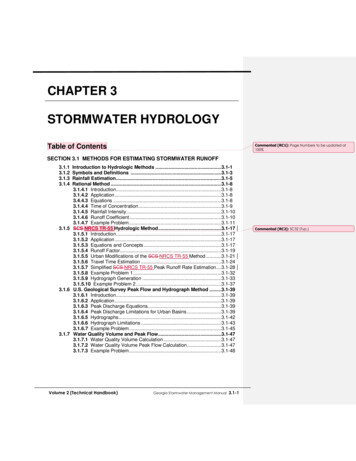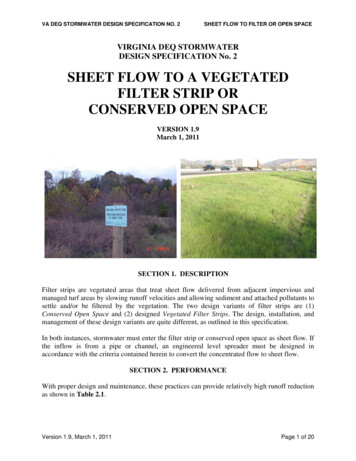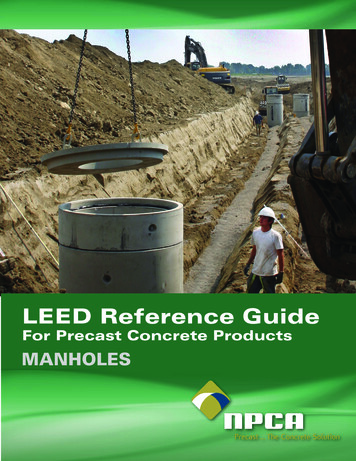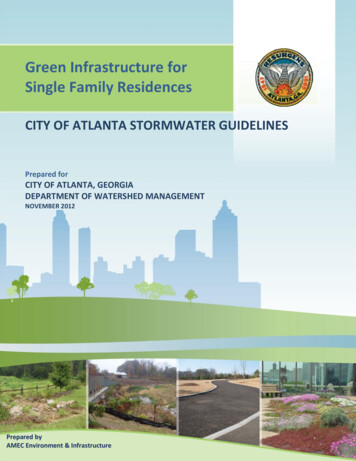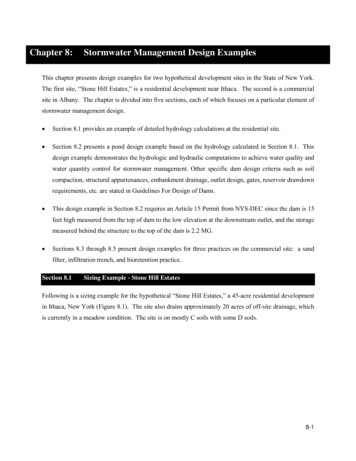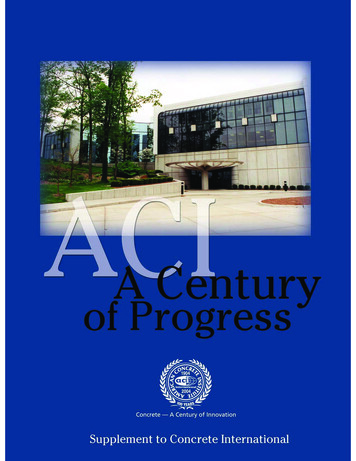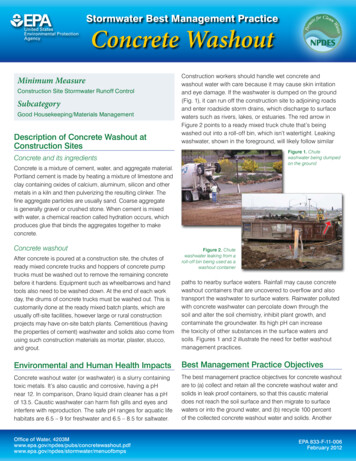
Transcription
Stormwater Best Management PracticeConcrete WashoutMinimum MeasureConstruction Site Stormwater Runoff ControlSubcategoryGood Housekeeping/Materials ManagementDescription of Concrete Washout atConstruction SitesConstruction workers should handle wet concrete andwashout water with care because it may cause skin irritationand eye damage. If the washwater is dumped on the ground(Fig. 1), it can run off the construction site to adjoining roadsand enter roadside storm drains, which discharge to surfacewaters such as rivers, lakes, or estuaries. The red arrow inFigure 2 points to a ready mixed truck chute that’s beingwashed out into a roll-off bin, which isn’t watertight. Leakingwashwater, shown in the foreground, will likely follow similarFigure 1. Chutewashwater being dumpedon the groundConcrete and its ingredientsConcrete is a mixture of cement, water, and aggregate material.Portland cement is made by heating a mixture of limestone andclay containing oxides of calcium, aluminum, silicon and othermetals in a kiln and then pulverizing the resulting clinker. Thefine aggregate particles are usually sand. Coarse aggregateis generally gravel or crushed stone. When cement is mixedwith water, a chemical reaction called hydration occurs, whichproduces glue that binds the aggregates together to makeconcrete.Concrete washoutFigure 2. Chutewashwater leaking from aroll-off bin being used as awashout containerAfter concrete is poured at a construction site, the chutes ofready mixed concrete trucks and hoppers of concrete pumptrucks must be washed out to remove the remaining concretebefore it hardens. Equipment such as wheelbarrows and handtools also need to be washed down. At the end of each workday, the drums of concrete trucks must be washed out. This iscustomarily done at the ready mixed batch plants, which areusually off-site facilities, however large or rural constructionprojects may have on-site batch plants. Cementitious (havingthe properties of cement) washwater and solids also come fromusing such construction materials as mortar, plaster, stucco,and grout.paths to nearby surface waters. Rainfall may cause concretewashout containers that are uncovered to overflow and alsotransport the washwater to surface waters. Rainwater pollutedwith concrete washwater can percolate down through thesoil and alter the soil chemistry, inhibit plant growth, andcontaminate the groundwater. Its high pH can increasethe toxicity of other substances in the surface waters andsoils. Figures 1 and 2 illustrate the need for better washoutmanagement practices.Environmental and Human Health ImpactsBest Management Practice ObjectivesConcrete washout water (or washwater) is a slurry containingtoxic metals. It’s also caustic and corrosive, having a pHnear 12. In comparison, Drano liquid drain cleaner has a pHof 13.5. Caustic washwater can harm fish gills and eyes andinterfere with reproduction. The safe pH ranges for aquatic lifehabitats are 6.5 – 9 for freshwater and 6.5 – 8.5 for saltwater.The best management practice objectives for concrete washoutare to (a) collect and retain all the concrete washout water andsolids in leak proof containers, so that this caustic materialdoes not reach the soil surface and then migrate to surfacewaters or into the ground water, and (b) recycle 100 percentof the collected concrete washout water and solids. AnotherOffice of Water, .epa.gov/npdes/stormwater/menuofbmpsEPA 833-F-11-006February 2012
Stormwater Best Management Practice: Concrete Washoutcontacted to inquireabout any pretreatmentrequirements, i.e., theNational PretreatmentStandards for ProhibitedDischargers (40CFR 403.5)before discharging thewashwater to the POTW.The washwater can alsoFigure 4. Vacuuming washwater out of abe retained in the washoutwashout container for treatment and reusecontainer and allowed toevaporate, leaving only the hardened cementitious solids to berecycled.objective is to support the diversion of recyclable materials fromlandfills. Table 1 shows how concrete washout materials can berecycled and reused.Table 1 – Recycling concrete washout materialsxbxxxxxxxxxUnused regateReused to washout additional mixertruck chutes or drumsReused as a ready mixed concreteingredientReused as an ingredient of precastconcrete products, e.g., highwaybarriers, retaining wall blocks, riprapReused as crushed concreteproducts, e.g., road base or fillReused to pave the yards of readymixed concrete plantsReturned back to a surface water,e.g., river, lake, or estuaryCementfinesaUses of Recycled MaterialsWashwaterConcrete Washout MaterialsxxSolids recyclingxThe course aggregate materials that are washed off concretetruck chutes into a washout container can be either separatedby a screen and placed in aggregate bins to be reused atthe construction site or returned to the ready mixed plant andwashed into a reclaimer (Fig. 5). When washed out into areclaimer, the fine and course aggregates are separated outand placed in differentpiles or bins to be reusedin making fresh concrete.Reclaimers with settlingtanks separate cementfines from the washwater,and these fines can alsobe used in new concreteunless prohibited by theFigure 5. Ready mixed truck washinguser’s concrete qualityout into a reclaimerspecifications.xxca. Fine particles of cementitious material (e.g., Portland cement, slag cement, fly ash,silica fume)b. Recyclable, if allowed by the concrete quality specificationsc. Treated to reduce the pH and remove metals, so it can be delivered to a municipalwastewater treatment plant, where it is treated further and then returned to a naturalsurface waterWashwater recycling, treatment, disposalWashwater from concrete truckchutes, hand mixers, or otherequipment can be passed througha system of weirs or filters to removesolids and then be reused to washdown more chutes and equipmentat the construction site or as aningredient for making additionalconcrete. A three chamber washoutfilter is shown in Figure 3. The firststage collects the coarse aggregate.The middle stage filters out theFigure 3. Concrete washoutfiltersmall grit and sand. The third stagehas an array of tablets that filterout fines and reduces the pH. The filtered washwater is thendischarged through a filter sock. An alternative is to pump thewashout water out of the washout container (Fig 4) and treatthe washwater off site to remove metals and reduce its pH,so it can be delivered to a publicly owned treatment works(POTW), also known as a municipal wastewater treatment plant,which provides additional treatment allowing the washwaterto be discharged to a surface water. The POTW should beHardened concrete recyclingWhen the washwater in a construction site concrete washoutcontainer has been removed or allowed to evaporate, thehardened concrete that remains can be crushed (Fig. 6)and reused as a construction material. It makes an excellentaggregate for road base and can be used as fill at theconstruction site ordelivered to a recycler.Concrete recyclers canbe found at municipalsolid waste disposalfacilities, privaterecycling plants, or largeFigure 6. Crushed concrete stockpile andcrusherconstruction sites.2
Stormwater Best Management Practice: Concrete WashoutWet concrete recyclingdriver then washes downthe chute into the bucket toremove any cementitiousmaterial before it hardens.After washing out the chute,the driver pumps (yellowarrow points to the pump)the washwater, sand, andFigure 8. Chute washout bucket andother fine solids from thepumpbucket up into the truck’sdrum to be returned to theready mixed plant, where it can be washed into a reclaimer.A removable screen at the bottom of the washout bucketprevents course aggregate from entering the pump. Thiscourse aggregate can also be returned to the plant and addedto the coarse aggregate pile to be reused. All the materials arerecycled.Builders often order a little more ready mixed concrete thanthey actually need, so it is common for concrete trucks tohave wet concrete remaining in their drum after a delivery. Thisunused concrete can be returned to the ready mixed plant andeither (1) used to pour precast concrete products (e.g., highwaybarriers, retaining wall blocks, riprap), (2) used to pave theready mixed plant’s yard, (3) washed into a reclaimer, or(4) dumped on an impervious surface and allowed to harden,so it can be crushed and recycled as aggregate. Unused wetconcrete should not be dumped on bare ground to harden atconstruction sites because this can contribute to ground waterand surface water contamination.Washout ContainersDifferent types of washout containers are available forcollecting, retaining, and recycling the washwater and solidsfrom washing down mixed truck chutes and pump truckhoppers at construction sites.Hay bale and plastic washout pitA washout pit made with hay bales and a plastic lining is shownin Figure 9. Such pits can be dug into the ground or built abovegrade. The plastic lining should be free of tears or holes thatwould allow the washwater to escape (Fig. 10). After the pit isused to wash down the chutes of multiple ready mixed trucksand the washwater has evaporated or has been vacuumed off,the remaining hardened solids can be broken up and removedfrom the pit. This process may damage the hay bales andplastic lining. If damage occurs, the pit will need to be repairedand relined with new plastic. When the hardened solids areremoved, they may be bound up with the plastic lining and haveto be sent to a landfill, rather than recycled. Recyclers usuallyaccept only unmixed material. If the pit is going to be emptiedand repaired more than a few times, the hay bales and plasticwill be generating additional solid waste. Ready mixed concreteChute washout boxA chute washout box is mounted on the back of the readymixed truck. If the truck has three chutes, the followingprocedure is used to perform the washout from the top down:(1) after the pour is completed, the driver attaches the extensionchute to the washout box, (2) the driver then rotates the mainchute over the extension chute (Fig. 7) and washes down thehopper first then the main chute, (3) finally the driver washesdown the flop down chute and last the extension chute hangingon the box. All washwater and solids are captured in the box.After the wash down,washwater and solids arereturned to the ready mixedplant for recycling. A filterbasket near the top of thewashout box separates outthe coarse aggregates sothey can be placed in abin for reuse either at theconstruction site or back atFigure 7. Chute washout boxthe cement plant.Figure 9. Hay bale and plasticwashout pitFigure 10. Leakingwashout pit thathas not been wellmaintainedChute washout bucket and pumpAfter delivering ready mixed concrete and scraping the last ofthe customer’s concrete down the chute, the driver hangs awashout bucket shown in Figure 8 (see red arrow) on the end ofthe truck’s chute and secures the hose to insure no leaks. The3
Stormwater Best Management Practice: Concrete Washouttrucks can use hay bale washout pits, but concrete pumptrucks have a low hanging hopper in the back that may preventtheir being washed out into bale-lined pits.subsequent discharge to a surface water. Everything is recycledor treated sufficiently to be returned to a natural surface water.Figure 14. Pump truck using theramp to wash out into a roll-off binVinyl washout containerThe vinyl washoutcontainer (Fig. 11) isportable, reusable, andeasier to install than ahay bale washout pit.The biodegradable filterFigure 11. Vinyl washout pit with filter bagbag (Fig. 12) assists inextracting the concrete solids and prolongs the life of the vinylcontainer. When the bag is lifted, the water is filtered out andthe remaining concrete solids and the bag can be disposed oftogether in a landfill, or the hardened concrete can be deliveredto a recycler. After the solids have been removed several timesand the container is full of washwater, the washwater can beallowed to evaporate, so the container can be reused. Thewashwater can be removed more quickly by placing anotherfilter bag in the containerand spreading water gellinggranules evenly across thewater. In about five minutes,the water in the filter bag willturn into a gel that can beremoved with the bag. Thenthe gel and filter bag can bedisposed to together.Figure 12. Extracting the concreteMetal washout containerFigure 15.Deliveringhardened Concreteto a recyclerAnother metal, portable, washout container, which has arain cover to prevent overflowing, is shown in Figure 16. It isaccompanied by an onsite washwater treatment unit, whichreduces the pH and uses a forced weir tank system to removethe coarse aggregate, fine aggregate, and cement fines. Thewashwater canthen be reused atthe constructionsite to washout other mixertruck chutesand equipment.Figure 16. Washout container with a rain cover andonsite washwater treatmentThe solids areallowed to hardentogether and canbe taken to a concreterecycler (Fig. 17) to becrushed and used asroad base or aggregatefor making precastproducts, such asretaining wall blocks. AllFigure 17. Delivering hardened concreteto a recyclermaterials are recycled.solids or gelled washwaterThe metal roll-off bin (Fig. 13) is designed to securely containconcrete washwater and solids and is portable and reusable.It also has a ramp that allows concrete pump trucks to washout their hoppers (Fig. 14). Roll-off providers offer recyclingservices, such as, picking up the roll-off bins after thewashwater has evaporated and the solids have hardened,replacing them withempty washout bins, anddelivering the hardenedconcrete to a recycler(Fig. 15), rather than alandfill. Some providers willvacuum off the washwater,treat it to remove metals andreduce the pH, deliver it to awastewater treatment plantFigure 13. Mixer truck being washed outfor additional treatment and into a roll-off binSiting Washout FacilitiesConcrete washout facilities, such as washout pits and vinylor metal washout containers, should be placed in locationsthat provide convenient access to concrete trucks, preferablynear the area where concrete is being poured. However they4
Stormwater Best Management Practice: Concrete WashoutReferenceshould not be placed within 50 feet of storm drains, openditches, or waterbodies. Appropriate gravel or rock shouldcover approaches to concrete washout facilities when they arelocated on undeveloped property. On large sites with extensiveconcrete work, washouts should be placed at multiple locationsfor ease of use by ready mixed truck drivers. If the washoutfacility is not within view from the pour location, signage will beneeded to direct the truck drivers.NRMCA 2009. Environmental Management in the ReadyMixed Concrete Industry, 2PEMRM, 1st edition. By Gary M.Mullins. Silver Springs, MD: National Ready Mixed ConcreteAssociation.Websites and VideosConstruction Materials Recycling Associationwww.concreterecycling.orgOperating and Inspecting WashoutFacilitiesConcrete washout facilities should be inspected daily and afterheavy rains to check for leaks, identify any plastic linings andsidewalls have been damaged by construction activities, anddetermine whether they have been filled to over 75 percentcapacity. When the washout container is filled to over75 percent of its capacity, the washwater should be vacuumedoff or allowed to evaporate to avoid overflows. Then when theremaining cementitious solids have hardened, they should beremoved and recycled. Damages to the container should berepaired promptly. Before heavy rains, the washout container’sliquid level should be lowered or the container should becovered to avoid an overflow during the rain storm.National Ready Mixed Concrete Associationwww.nrmca.orgEducating Concrete SubcontractorsFigure 3. Mark Shaw, Ultra Tech International, Inc.National Ready Mixed Concrete Research and l information and videos on concrete washoutcontainers and systems can be found by a web search for“concrete washout.”Photograph CreditsFigures 1, 2. Mark Jenkins, Concrete Washout Systems, Inc.Figure 4. Mark Jenkins, Concrete Washout Systems, Inc.The construction site superintendent should make ready mixedtruck drivers aware of washout facility locations and be watchfulfor improper dumping of cementitious material. In addition,concrete washout requirements should be included in contractswith concrete delivery companies.Figure 5. Christopher Crouch, CCI ConsultingFigure 6. William Turley, Construction Materials Recycling AssociationFigure 7. Brad Burke, Innovative Concrete Solutions, LLCFigure 8. Ron Lankester, EnviroguardFigures 9, 10. Mark Jenkins, Concrete Washout Systems, Inc.Figures 11, 12. Tom Card, RTC SupplyFigures 13, 14, 15. Mark Jenkins, Concrete Washout Systems, Inc.Figures 16, 17. Rick Abney Sr., Waste Crete Systems, LLPDisclaimerPlease note that EPA has provided external links because they provide additional information that may be useful or interesting. EPA cannot attest to theaccuracy of non-EPA information provided by these third-party websites and does not endorse any non-government organizations or their products or services.5
Stormwater Best Management Practice. Concrete Washout . Stormwater Best Management Practice: Concrete Washout. 2. objective is to support the diversion of recyclable materials from . landfills. Table 1 shows how concre


